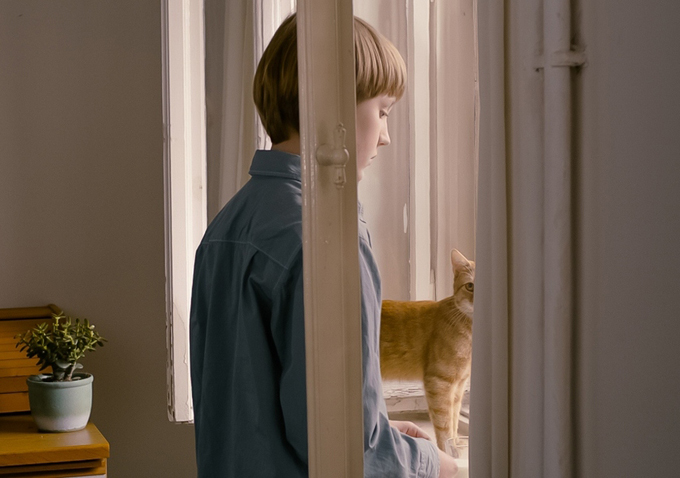
If ever there were a case of a film being a reflecting pool of the viewer’s understanding, rather than a monolithic piece of work that we can either get wrong or right in terms of its author’s intentions, “The Strange Little Cat,” which plays this week during the Göteborg International Film Festival, is it. This we know, having idly followed the film’s progress from its under-the-radar premiere in Berlin last year, through its Cannes bow in the equivalent of an off-off-Broadway sidebar, ultimately to a couple of end-of-year lists (especially those dedicated to films without a distribution deal). Over those months, quiet, impressive notices have collected around the film’s reputation; the warmth of the praise only equalled by the complete, almost comical, disparity of the interpretation. Critics unanimously admire it, but have wildly different ideas of what “it” is. This in itself is not that unusual; there are opaque, arty films, where one has to piece together what-really-happened, or what-it-all-means, made everyday, but “The Strange Little Cat” instead manages the near-unique trick of inspiring wildly different impressions of its tone. We’ve seen it described as deeply melancholic, a borderline horror movie, a comic romp, and a blithely surreal soap opera—each by reviewers as convinced of the singular validity of their interpretation as ever they have been. They are, of course, all completely wrong.
Hah, kidding, we’re not that full of hubris, but with the benefit of retrospective context, as well as having spoken to a few people after our screening, we realize that our sense of the film’s mood is yet another different take, but fully as deeply-held as any of the previous conflicting reports. It’s really quite remarkable, and perhaps more than any other aspect of the film, speaks to the peculiar power of its deceptive minimalism: it is a chimera.

What’s even more impressive is that this mutability is in no way the result of a lack of confidence on the part of first-time (actually student) filmmaker Ramon Zurcher. In fact, there’s a scalpel-like precision to the both the shooting and the editing, which had to have been difficult to achieve given the challenges choreographing such a lot of people, and three non-human actors (the titular cat—actually one of the less strange participants,—a dog, and a moth) in such a cramped space (a smallish Berlin apartment.) Actually, it’s a film that abounds in story (and stories) but has very little plot on a macro level: a seemingly ordinary family lives out what seems to be, for them, an ordinary Sunday, which culminates in a meal shared by the extended family unit.
But it’s on a micro level that the film really happens—moment to moment. People bustle in and out of the small kitchen: little Clara (Mia Kasalo), who’s bad at spelling, screams loudly whenever an appliance is switched on; elder brother Simon (Luk Pfaff) sleeps late but rises in time to fetch Grandma; the next door neighbor drops by with his sullen son to fix a broken washing machine; the sardonic daughter (a particularly terrific Anjorke Strechel) staying for the weekend eats oranges and smokes; and at the calm center of it all, is the mother, from whose watchful, occasionally lonely-seeming presence the family seems to derive their oddball energy. Because in addition to the ordinary, or lying just beneath it, is something much odder—there’s a bottle that spins of its own accord, a sausage that spits its juice with seeming malevolent intent, a series of inconsequential but deadpan anecdotes delivered between characters, and most of all there’s the way they interact. They have the brilliantly evoked, relatable ease of a group of people utterly familiar with each other’s rhythms and thoughts—even bodies, as they squeeze past each other in small spaces, or share the sink to brush their teeth—but at the same time they might as well be aliens, or beings from a parallel universe, in how they converse and how they react to moments of what seems to be for them, totally everyday surreality.

It’s the union of the completely bizarre with the utterly banal that keeps our attention, even after the lack of plot or arc might have otherwise made us tune out. In fact, unlike many puzzles that tease solutions but never deliver, here the film becomes more engaging as time goes on, so that by the end our attention was unexpectedly rapt. Perhaps it is because, on that instantaneous level, the film (to us anyway; it’s a very subjective thing) is strangely joyous and warm—they are all so complicit in each other’s weirdness. In fact, in this mini-universe that refers only to itself (imagine a non-creepy “Dogtooth”), it’s the viewer who’s the weirdo, trying to apply patterns that simply don’t fit, onto a system that abides by its own unseen logic instead. The family’s evident, yet unspoken acceptance and love for each other’s eccentricities, makes it for us a heartwarming, if mischievous, tribute to family life, a heightened version of that feeling we all got as kids staying in a friend’s house for the first time and discovering rituals different to our own: wow, their house smells weird! Wait, they’re allowed have the TV on during dinner?
This kind of vérité surrealism doesn’t come along very often, and the glorious oddness that Zurcher manages to infuse into even the most routinely domestic activities is really the gift the film keeps on giving. Apparently based on an idea workshopped at a program run by Bela Tarr (he gets a credit namecheck), it takes a little while to work its magic, and you need to go with the flow, but we heartily recommend you do as soon as it gets the distribution it deserves. Because of its many little pleasures, yes, but also because whatever mix of terrifying, boring, amusing, mysterious, upsetting and tragic you get from it, it’s very possible that you’ll be the only one on whom “The Strange Little Cat” has that exact cocktail of effects. [B+]

